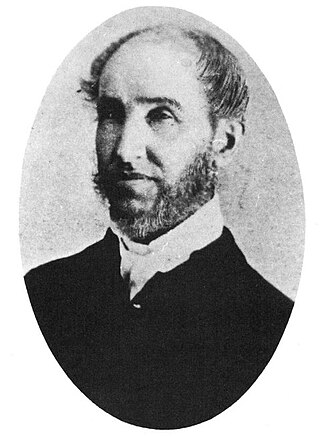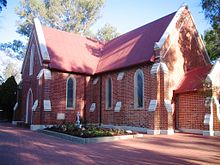
The Church of Our Lady and Saint Nicholas is the Anglican parish church of Liverpool. The site is said to have been a place of worship since at least the 1250s. The church is situated close to the River Mersey near the Pier Head. The Chapel of St Nicholas was built on the site of St Mary del Quay, which in 1355 was determined to be too small for the growing borough of Liverpool. It is recorded in the National Heritage List for England as a designated Grade II listed building, and is an active parish church in the diocese of Liverpool, the archdeaconry of Liverpool and the deanery of Liverpool North. It is part of the Greater Churches Group. From 1813 to 1868 the church was the tallest building in Liverpool at 174 feet [53 m], but then surpassed by the Welsh Presbyterian Church in Toxteth.

Churchstoke or Church Stoke is a village, community and electoral ward in Montgomeryshire, Powys, Wales. Located in the southeast of the Vale of Montgomery, it is overlooked by Todleth Hill, Roundton Hill and Corndon Hill. The rivers Caebitra and Camlad have their confluence just outside the village. The nearest town is Montgomery. In the 2011 census the village had a population of 708.

St Mary's Church, Handsworth, also known as Handsworth Old Church, is a Grade II* listed Anglican church in Handsworth, Birmingham, England. Its ten-acre (4 hectare) grounds are contiguous with Handsworth Park. It lies just off the Birmingham Outer Circle, and south of a cutting housing the site of the former Handsworth Wood railway station. It is noteworthy as the resting place of famous progenitors of the industrial age, and has been described as the "Cathedral of the Industrial Revolution".

The All Saints Church in Henley Brook is the oldest church in Western Australia. It was built by Richard Edwards between 1838 and 1840, with the first service taking place on 10 January 1841. The site is on a small hill overlooking the Swan River and near the conjunction of the Swan and Ellen Brook. This site was where Captain James Stirling camped during his 1827 exploration of the area.

William Mitchell was a Church of England priest who was the second ordained person, after Louis Giustiniani, to provide religious services in the Swan Valley area of the Swan River Colony. He worked in the Swan Parish for over 20 years before moving to Perth to take up a position working with convicts and prisoners in the Perth Gaol in Beaufort Street.

The Church of St Augustine of Hippo in Lyttelton Road, Edgbaston, Birmingham, England, is a parish church in the Church of England.

East Perth Cemeteries was the first cemetery established for the Swan River Colony in 1829 in East Perth, Western Australia. It is estimated that as many as 10,000 people were buried there between 1829 and 1919 in seven independently administered denominations or sections which is why the place is known as 'East Perth Cemeteries'. Only around 800 gravesites have been identified. A large section of the original site has since been built over, leaving about 5 hectares remaining.

St Mary's Church is in the village of Whitegate, Cheshire, England. It is an active Anglican parish church in the diocese of Chester, the archdeaconry of Chester and the deanery of Middlewich. Its benefice is combined with that of St Peter, Little Budworth. The church is recorded in the National Heritage List for England as a designated Grade II listed building. The authors of the Buildings of England series state that the "church is placed so happily against trees on a hillside that it makes the perfect, comforting picture of the Victorian village church".

The English coastal city of Brighton and Hove, made up of the formerly separate Boroughs of Brighton and Hove in East Sussex, has a wide range of cemeteries throughout its urban area. Many were established in the mid-19th century, a time in which the Victorian "cult of death" encouraged extravagant, expensive memorials set in carefully cultivated landscapes which were even recommended as tourist attractions. Some of the largest, such as the Extra Mural Cemetery and the Brighton and Preston Cemetery, were set in particularly impressive natural landscapes. Brighton and Hove City Council, the local authority responsible for public services in the city, manages seven cemeteries, one of which also has the city's main crematorium. An eighth cemetery and a second crematorium are owned by a private company. Many cemeteries are full and no longer accept new burials. The council maintains administrative offices and a mortuary at the Woodvale Cemetery, and employs a coroner and support staff.

St Mary's Priory Church, in Whitecross Street, Monmouth, Monmouthshire, Wales, is an Anglican church founded as a Benedictine priory in 1075. The current church dates mostly from the 18th and 19th centuries. It was designated a Grade II* listed building in 1952. It is one of 24 buildings on the Monmouth Heritage Trail.

St Matthew's Church is a heritage-listed Anglican church in Stirling Square, Guildford, Western Australia. The church is part of the Anglican Diocese of Perth.

St Matthews Anglican Church is a heritage-listed church and cemetery at 35 Church Road, Mitchelton, City of Brisbane, Queensland, Australia. It was designed by Charles Tiffin and built from 1867 to 1869 by Mr Mahoney. It is also known as Grovely Church, as it is within the Parish of Grovely. It was added to the Queensland Heritage Register on 21 October 1992.

All Saints Anglican Church and cemetery Yandilla is a heritage-listed Anglican church at Gore Highway, Yandilla, Toowoomba Region, Queensland, Australia. It was built about 1878 by John Baillie. It is also known as All Saints Church of England. It was added to the Queensland Heritage Register on 21 October 1992.

St Patrick's Church is a heritage-listed Roman Catholic church at Rosewood - Aratula Road, Rosevale, Scenic Rim Region, Queensland, Australia. It was designed by Father Andrew Horan and built from 1888 to 1889. It was added to the Queensland Heritage Register on 11 December 2009.

St John's Anglican Church, also known as St John the Evangelist Anglican Church, is a heritage-listed Anglican church on York Street in Albany, Western Australia. The church is the oldest consecrated church in Western Australia, consecrated in October 1848.

St Mary the Virgin is the Church of England parish church for East Barnet within the Diocese of St Albans. It is located on Church Hill.
Charles Harper was Toodyay's first Anglican minister, and the first ordinand from Western Australia. While being a minister of the church was probably far from his intentions when he set sail for the Swan River Colony in 1837, his family's clerical background and his own disposition suited him well for this vocation. Harper served the Toodyay district for over 30 years, first as registrar of births, deaths and marriages, then from 1849 as an ordained minister.

The Church of St Mary the Blessed Virgin is an Anglican church in Addington, in the Borough of Croydon, London. It is associated with the Archbishops of Canterbury of the 19th century, who lived at nearby Addington Palace: five of the archbishops are buried at the church.

St Thomas' Anglican Church is a heritage-listed Anglican church located in the western Sydney suburb of Mulgoa in the City of Penrith local government area of New South Wales, Australia. The church forms part of the Diocese of Sydney. It was designed by Reverend Thomas Makinson, first incumbent priest and James Chadley and built from 1836 to 1838 by James Atkinson and William Chisholm. It is also known as St. Thomas Anglican Church and St Thomas Church of England. The property is owned by Anglican Church Property Trust. It was added to the New South Wales State Heritage Register on 2 April 1999.

St Mary's Anglican Church is a heritage-listed Anglican church in Peel Terrace, Busselton, Western Australia. It is possibly the oldest stone church in the state. Opened in 1845, and consecrated in 1848, it has been the subject of a number of additions, and has also been repaired or conserved on several occasions.




















